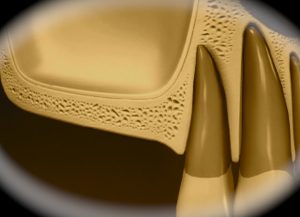There are several types of bone graft procedures and materials available, each one appropriate for different types of bone deficiencies. The goal is to augment missing bone and create the right foundation for the implant and the overlying crowns or bridges. Depending on the degree of bone deficiency, this may be done in one surgery or multiple stages as necessary. Following consultation with Dr. Kazemi, we will provide you with all the treatment details and then review it with your restorative dentist.
The Type of Bone Grafting is Based on:
- Height and width of existing bone
- Location of the implants
- Functional requirements of the teeth being replaced
- Aesthetic elements of teeth being replaced
- Need for preservation or augmentation
Extraction Site Bone Grafting
If there is loss of bone from trauma or infection, it is best to immediately place a bone graft into the extraction site to preserve and augment the missing bone for future implant placement. This is known as preservation and augmentation grafting and is performed at the time of extraction. This is critical in forming a proper site for an implant as it will influence the ultimate function and aesthetics of the final crown. The bone graft is allowed to heal for four to six months before the site is ready for implant placement. If the tooth is in the smile zone, a well-crafted temporary prosthesis must be placed by the restorative dentist to help guide the gum tissue during healing. Bone-grafting is also indicated when the bone is normal, but a patient, for whatever reason, may have decided to postpone an implant beyond three months.
Horizontal Bone Augmentation:
Horizontal bone grafting is performed when the bone is too thin to support a dental implant. Bone graft increases the width and allows proper positioning and support of dental implants. It also creates better gum tissue form for easy cleaning and improved aesthetics.

Vertical Bone Augmentation
Vertical bone grafting is performed when there is inadequate height of bone for the implant. Loss of bone height may occur from gum disease, trauma, tooth loss, or from the close proximity of the maxillary sinus in back of the upper jaw. Bone grafting increases the bone height to support implants with the ideal length and position for long term success.
